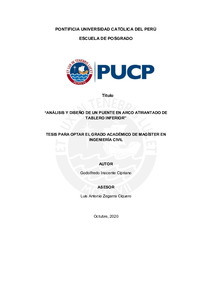| dc.contributor.advisor | Zegarra Ciquero, Luis Antonio | |
| dc.contributor.author | Inocente Cipriano, Godolfredo | |
| dc.date.accessioned | 2021-08-11T17:48:52Z | |
| dc.date.available | 2021-08-11T17:48:52Z | |
| dc.date.created | 2020 | |
| dc.date.issued | 2021-08-11 | es_ES |
| dc.identifier.uri | http://hdl.handle.net/20.500.12404/19913 | |
| dc.description.abstract | El diseño de un Puente en Arco Atirantado de Tablero Inferior es de gran importancia en nuestro país, ya que permite cubrir obstáculos sin necesidad de apoyos intermedios, tiene bajo costo de mantenimiento en comparación a puentes continuos con apoyos intermedios y lo más importante evita pérdidas de vidas humanas al no exponer su estructura en el lecho del río. El objetivo de esta tesis es presentar el comportamiento general del puente, procedimiento de análisis y diseño de cada elemento de la superestructura de un Puente en Arco Atirantado de Tablero Inferior. En particular se presenta el diseño de un Puente en Arco Atirantado de Tablero Inferior de 65 m de luz y 4 líneas de tráfico, determinando recomendaciones de los elementos y conexiones, que sirva de consulta para la concepción de este tipo de puente. El estudio se inicia con el comportamiento general del puente, experiencia del puente Topará colapsado y algunas consideraciones específicas de los elementos del puente, como es la disposición de péndolas, rotura de péndolas, efectos de no linealidad geométrica, tipos de arriostramientos y conexiones. En la parte del redimensionamiento, se determina la geometría inicial del puente para realizar el análisis en base a referencias bibliográficas y experiencias en este tipo de puente arco atirantado. El análisis del Puente en Arco Atirantado de Tablero Inferior, se realiza para cargas permanentes y variables. El análisis sísmico se realiza mediante un análisis modal espectral y se estudia la influencia de la componente vertical del sismo. También se estudia el análisis no lineal geométrico para determinar el efecto de las grandes fuerzas de tracción o compresión en la estructura. Finalmente, se desarrolla el diseño de los elementos y conexiones del Puente en Arco Atirantado de Tablero Inferior, estableciendo un procedimiento para hacer el diseño más eficiente y rápido. Se realiza el diseño de la viga cajón, arco, péndolas y su conexión, viga diafragma, viga arriostre, tablero y el apoyo del puente. En el anexo se presenta los planos de estructuras del diseño. El análisis y diseño de este tipo de puente arco atirantado se realiza en base al Manual de puentes del MTC y AASHTO LRFD. | es_ES |
| dc.description.abstract | The design of a Lower Deck Tied Arch Bridge is of great importance in our country, since it allows to cover obstacles without the need for intermediate supports, has low maintenance costs compared to continuous bridges with intermediate supports and most importantly prevents losses of human lives by not exposing its structure in the river bed. The objective of this thesis is to present the general behavior of the bridge, análisis and design procedure of each element of the superstructure of a Lower Deck Tied Arch Bridge. In particular, the design of a Lower Deck Tied Arch Bridge with a span of 65 m and 4 traffic lines is presented, determining recommendations of the elements and connections, which serves as a consultation for the conception of this type of bridge. The study begins with the general behavior of the bridge, experience of the collapsed Topará bridge and some specific considerations of the elements of the bridge, such as the arrangement of hangers, breakage of hangers, effects of geometric nonlinearity, types of bracing and connections. In the predimensioning part, the initial geometry of the bridge is determined to perform the analysis based on bibliographic references and experiences in this type of tied arch bridge. The analysis of the Lower Deck Tied Arch Bridge is performed for permanent and variable loads. The seismic analysis is performed by means of a spectral modal analysis and the influence of the vertical component of the earthquake is studied. The geometric nonlinear analysis is also studied to determine the effect of large tensile or compression forces on the structure. Finally, the design of the elements and connections of the Lower Deck Tied Arch Bridge is developed, establishing a procedure to make the design more efficient and faster. The design is made of the box beam, arch, hangers and their connection, diaphragm beam, bracing beam, deck and bridge support. The annex presents the design structure drawings. The analysis and design of this type of tied arch bridge is based on the MTC Bridge Manual and AASHTO LRFD. | es_ES |
| dc.language.iso | spa | es_ES |
| dc.publisher | Pontificia Universidad Católica del Perú | es_ES |
| dc.rights | info:eu-repo/semantics/closedAccess | es_ES |
| dc.subject | Puentes atirantados--Diseño y construcción | es_ES |
| dc.title | Análisis y diseño de un puente en arco atirantado de tablero inferior | es_ES |
| dc.type | info:eu-repo/semantics/masterThesis | es_ES |
| thesis.degree.name | Maestro en Ingeniería Civil | es_ES |
| thesis.degree.level | Maestría | es_ES |
| thesis.degree.grantor | Pontificia Universidad Católica del Perú. Escuela de Posgrado. | es_ES |
| thesis.degree.discipline | Ingeniería Civil | es_ES |
| renati.advisor.dni | 07778632 | |
| renati.advisor.orcid | https://orcid.org/0000-0001-5923-5785 | es_ES |
| renati.author.dni | 41582526 | |
| renati.discipline | 732267 | es_ES |
| renati.juror | Ottazzi Pasino, Gian Franco Antonio | |
| renati.juror | Zegarra Ciquero, Luis Antonio | |
| renati.juror | Acero Martinez, Jose Alberto | |
| renati.level | https://purl.org/pe-repo/renati/level#maestro | es_ES |
| renati.type | http://purl.org/pe-repo/renati/type#tesis | es_ES |
| dc.publisher.country | PE | es_ES |
| dc.subject.ocde | http://purl.org/pe-repo/ocde/ford#2.01.01 | es_ES |





